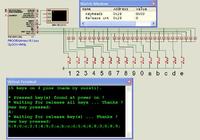zuisti
Advanced Member level 1
For decoding I'm using cheap Si diodes like 4148:

Key pressing is sensed via PORTB pin change IT, an the TIMER2 is used for a 20 msec debouncing.
Lookup table to define key return values.
Sensing depressed key(s) at power on.
Only one key can be pressed at a time (others are ignored), then it (all) must be released.
Written a small program to demonstrate the concept:
Attached a ZIP with the PROTON basic source, the HEX file and the DSN.
Sorry but I'm using also assembly snippets so for recompiling use the Proton 3506 (max).
What's your mind?
Greeting
zuisti

Key pressing is sensed via PORTB pin change IT, an the TIMER2 is used for a 20 msec debouncing.
Lookup table to define key return values.
Sensing depressed key(s) at power on.
Only one key can be pressed at a time (others are ignored), then it (all) must be released.
Written a small program to demonstrate the concept:
Attached a ZIP with the PROTON basic source, the HEX file and the DSN.
Sorry but I'm using also assembly snippets so for recompiling use the Proton 3506 (max).
What's your mind?
Greeting
zuisti